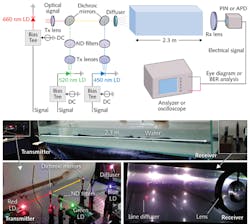Underwater communication and illumination uses RGB white-light laser source
To date, underwater optical communications using blue or blue-green lasers or LEDs are considered optimal to achieve high bandwidth and high data transmission rate. State-of-the-art wireless systems using single laser diodes can reach a transmission rate of 2.7 Gbit/s at a distance up to 34.5 m. Recently, researchers at Fudan University (Shanghai, China) and the University of Toronto (Toronto, ON, Canada) have demonstrated red/green/blue (RGB) laser-diode systems with transmission rates up to 3.4 Gbit/s at distances up to 2.3 m for a single laser diode and aggregate 9.7 Gbit/s using an on-off keying (OOK) modulation scheme for RGB laser-diode-based wavelength-division multiplexing (WDM). Furthermore, the multiplexed configuration also offers an RGB white-light underwater illumination capability that is not possible with single-laser-diode systems.
Using WDM technology, both underwater communications and underwater solid-state lighting are possible to cover a range of subsea explorations. The experiment used commercial gallium-nitride (GaN)-based 450 nm (blue) and 520 nm (green) laser diodes, as well as an aluminum-gallium-indium-phosphide (AlGaInP) 660 nm (red) laser diode in standard off-the-shelf packages, stabilized to around 25°C using a Peltier thermoelectric cooler. In addition to demonstrating high-bit-rate communication rates, the neutral-density filters and diffusers were used to balance the color outputs of the laser diodes to produce high-quality white light simultaneously with the communications channel, with respectable CIE color values and up to 7084 lux of illumination. Reference: X. Liu et al., Opt. Express, 26, 15, 19259–19274 (2018).
About the Author

Gail Overton
Senior Editor (2004-2020)
Gail has more than 30 years of engineering, marketing, product management, and editorial experience in the photonics and optical communications industry. Before joining the staff at Laser Focus World in 2004, she held many product management and product marketing roles in the fiber-optics industry, most notably at Hughes (El Segundo, CA), GTE Labs (Waltham, MA), Corning (Corning, NY), Photon Kinetics (Beaverton, OR), and Newport Corporation (Irvine, CA). During her marketing career, Gail published articles in WDM Solutions and Sensors magazine and traveled internationally to conduct product and sales training. Gail received her BS degree in physics, with an emphasis in optics, from San Diego State University in San Diego, CA in May 1986.
